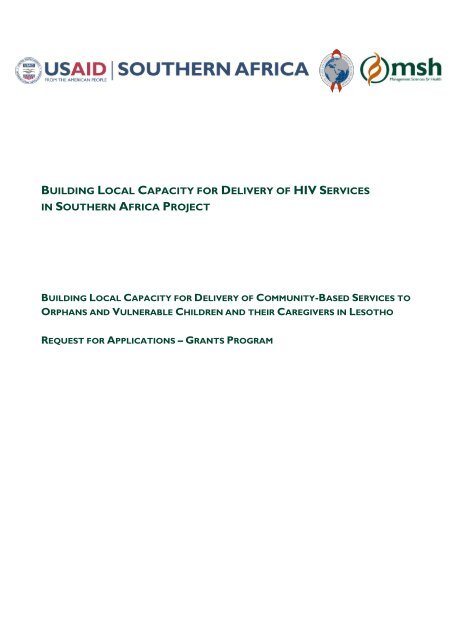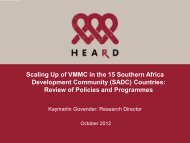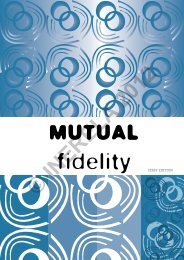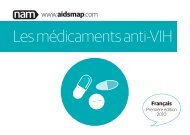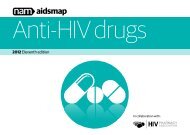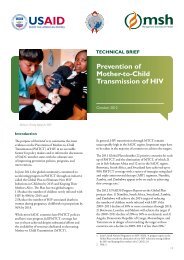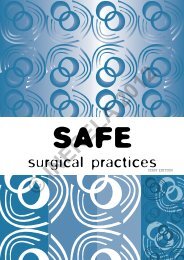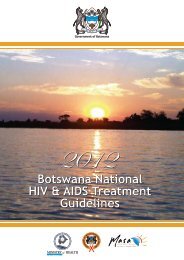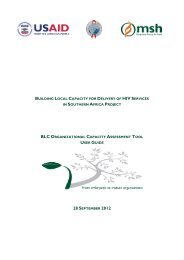Request for Applications for Lesotho Grants Program
Request for Applications for Lesotho Grants Program
Request for Applications for Lesotho Grants Program
Create successful ePaper yourself
Turn your PDF publications into a flip-book with our unique Google optimized e-Paper software.
BUILDING LOCAL CAPACITY FOR DELIVERY OF HIV SERVICES<br />
IN SOUTHERN AFRICA PROJECT<br />
BUILDING LOCAL CAPACITY FOR DELIVERY OF COMMUNITY-BASED SERVICES TO<br />
ORPHANS AND VULNERABLE CHILDREN AND THEIR CAREGIVERS IN LESOTHO<br />
REQUEST FOR APPLICATIONS – GRANTS PROGRAM
The views expressed in this publication do not necessarily reflect the views of the United States Agency <strong>for</strong><br />
International Development or the United States Government.<br />
Building Local Capacity <strong>for</strong> Delivery of HIV Services in Southern Africa Project<br />
Cooperative Agreement Number: LWA# GPO-A00-05-00024-00<br />
Leadership, Management and Sustainability <strong>Program</strong><br />
Management Sciences <strong>for</strong> Health<br />
Address:<br />
MSH <strong>Lesotho</strong><br />
1st Floor<br />
NBC Sechaba House<br />
Alliance Park<br />
Four Bowker Road<br />
Maseru, <strong>Lesotho</strong><br />
Tel No: (+266) 22 316 096<br />
Contact person: Joe Kumadzulo, <strong>Lesotho</strong> <strong>Grants</strong> Manager<br />
Email: blcsouthernafrica@msh.org
TABLE OF CONTENTS<br />
Table of Contents....................................................................................................................................... iii<br />
Acronyms .................................................................................................................................................... iv<br />
Section 1: Funding Opportunity Description ............................................................................................5<br />
1.0 OVERVIEW OF THE LESOTHO BLC PROJECT ................................................................................. 5<br />
1.1 <strong>Grants</strong> <strong>Program</strong> Purpose and Objectives ...................................................................................................... 5<br />
1.2 The purpose of the <strong>Grants</strong>.............................................................................................................................. 5<br />
1.2.1Proposed Activities .................................................................................................................................... 6<br />
1.2.2 Goals/Targets ........................................................................................................................................... 7<br />
1.3 Authorizing Legislation and Regulations ....................................................................................................... 8<br />
1.4 Award Administration ..................................................................................................................................... 8<br />
Section 2: AWARD INFORMATION ..................................................................................................... 10<br />
2.1Funding, Award Size ....................................................................................................................................... 10<br />
2.2 Start Date and Period of Per<strong>for</strong>mance ......................................................................................................... 10<br />
2.3 Termination of the <strong>Grants</strong> ............................................................................................................................ 10<br />
SECTION 3: ELIGIBILITY INFORMATION ..................................................................................... 10<br />
SECTION 4: APPLICATION AND SUBMISSION INFORMATION .............................................. 11<br />
4.1 Points of Contact and Delivery In<strong>for</strong>mation............................................................................................... 11<br />
4.2 Formats and Application Details .................................................................................................................. 12<br />
4.2.1 Proposal Guidelines ............................................................................................................................... 12<br />
4.2.2 Budget Guidelines .................................................................................................................................. 12<br />
Section 5: Application Review and Evaluation Process .......................................................................... 12<br />
5.1 PROPOSAL EVALUATION...................................................................................................................... 12<br />
5.1.1 The <strong>Grants</strong> Selection Committee .............................................................................................................. 14<br />
SECTION 6: AWARD ADMINISTRATION ......................................................................................... 14<br />
6.1 Grant Agreement ........................................................................................................................................... 14<br />
6.1.1 Type of Award ........................................................................................................................................ 14<br />
6.2 Reporting Requirements ................................................................................................................................ 14<br />
6.3 Monitoring and Evaluation Requirements ................................................................................................... 14<br />
SECTION 7: OTHER IMPORTANT INFORMATION ..................................................................... 15<br />
Annex 1: Proposal and budget Formats ................................................................................................... 16<br />
1.1 Proposal <strong>for</strong>mat, and guide notes ............................................................................................................ 16<br />
1.2 Budget <strong>for</strong>mat, and guide notes ............................................................................................................... 21<br />
Annex 2: attachments ................................................................................................................................ 22<br />
Annex 3: Project Summaries ..................................................................................................................... 23
ACRONYMS<br />
AIDS<br />
BLC<br />
CBO<br />
CSO<br />
DSW<br />
FBO<br />
HIV<br />
MOH<br />
MOSD<br />
MOLGC<br />
MOU<br />
MSH<br />
NGO<br />
OVC<br />
PEPFAR<br />
PLWHA<br />
PMP<br />
RHAP<br />
SADC<br />
SOW<br />
USAID<br />
Acquired Immunodeficiency Syndrome<br />
Building Local Capacity<br />
Community Based Organizations<br />
Civil Society Organization<br />
Department of Social Welfare<br />
Faith-based Organization<br />
Human Immunodeficiency Virus<br />
Ministry of Health<br />
Ministry of Social Development<br />
Ministry of Local Government and Chieftainship (<strong>Lesotho</strong>)<br />
Memorandum of Understanding<br />
Management Sciences <strong>for</strong> Health<br />
Non-governmental organization<br />
Orphans and Vulnerable Children<br />
President‟s Emergency Plan For AIDS Relief<br />
People Living with HIV/AIDS<br />
Per<strong>for</strong>mance Monitoring Plan<br />
Regional HIV/AIDS <strong>Program</strong><br />
Southern African Development Community<br />
Scope of Work<br />
United States Agency <strong>for</strong> International Development
SECTION 1: FUNDING OPPORTUNITY DESCRIPTION<br />
1.0 OVERVIEW OF THE LESOTHO BLC PROJECT<br />
The Building Local Capacity (BLC) <strong>for</strong> Delivery of HIV Services in Southern Africa Project is a five-year<br />
project (2010-2015) contributing to the United States Agency <strong>for</strong> International Development (USAID)<br />
Regional HIV/AIDS <strong>Program</strong> (RHAP) goal to strengthen the overall sustainability, quality, and reach of<br />
HIV/AIDS interventions in the region. BLC builds the capacity of government and civil society entities in<br />
the Southern Africa region, Angola, Botswana, <strong>Lesotho</strong>, Namibia, South Africa and Swaziland, to implement<br />
policies and health services <strong>for</strong> those infected with and affected by HIV and AIDS.<br />
The project‟s vision <strong>for</strong> <strong>Lesotho</strong> is that by the year 2015, the <strong>Lesotho</strong> Ministry of Social Development<br />
(MOSD), civil society organizations (CSOs), and development partners will work in coordination to directly<br />
provide and link orphaned and vulnerable children (OVC) and their caregivers to quality programming and<br />
services that are age and gender specific. They will work with community members, especially in remote<br />
areas, to ensure that interventions are applied through local mechanisms/structures targeted to each<br />
community and sustainable over time.<br />
In <strong>Lesotho</strong>, through the <strong>Grants</strong> <strong>Program</strong> and other activities, BLC contributes to the government‟s National<br />
Health and Social Welfare Strategic Plan (2006-2011), National OVC Strategic Plan (2011-2016), President‟s<br />
Emergency Plan <strong>for</strong> AIDS Relief (PEPFAR), <strong>Lesotho</strong>-US Partnership Framework 2009, and the<br />
USAID/RHAP goal to strengthen the overall sustainability, quality, and reach of community-based<br />
interventions given to OVC and their caregivers.<br />
1.1 <strong>Grants</strong> <strong>Program</strong> Purpose and Objectives<br />
The grants to be awarded through this solicitation will support local CSOs to implement activities that<br />
provide essential care and support services to OVC and their caregivers in <strong>Lesotho</strong>.<br />
1.2 The purpose of the <strong>Grants</strong><br />
The BLC <strong>Grants</strong> <strong>Program</strong> will award two grants <strong>for</strong> organizations to carry out activities in the following<br />
districts and specific community councils:<br />
1. Mohale‟s Hoek – in the community council of Siloe<br />
2. Qacha‟s Nek – in the community councils of Ntsupe and Tsoelikana<br />
It should be noted that the BLC project has supported two organizations to implement projects be<strong>for</strong>e in the<br />
above mentioned areas <strong>for</strong> a year. The project in Siloe community council in Mohale‟s Hoek will end in April<br />
2013; whilst the project in Ntsupe and Tsoelikana community councils in Qacha‟s Nek ended in September<br />
2012.<br />
The successful applicants will there<strong>for</strong>e propose projects that will continue to provide quality and sustainable<br />
services to OVC and their caregivers in these areas. The successful applicants are expected to provide<br />
services to the same individual beneficiaries that were reached during the first year (data on all individuals to<br />
be served will be provided to the successful applicants; out of safety and privacy concerns <strong>for</strong> the children,<br />
5
the data will not be made public). The services provided will depend on needs of the beneficiaries, whilst at<br />
the same time, building on services that have already been previously provided.<br />
Applicants are encouraged to consult the scope of work that was implemented in the first year of the<br />
respective project by the previous implementing partners so that they may develop a relevant project. Annex<br />
3 of the RFA contains the summary of scopes of work that the previous BLC-supported projects<br />
implemented in the areas mentioned above. However, applicants must also demonstrate that they have<br />
conducted participatory consultations with the stakeholders in the communities as part of the project<br />
conceptualization process to ensure that the local community needs are addressed and adequately responded<br />
to in the proposed project. There<strong>for</strong>e, as part of evidence that communities have been consulted, applicants<br />
will need to obtain an endorsement letter from the community councils (e.g. from community council<br />
secretary) confirming that targeted areas are those that were previously supported through BLC.<br />
1.2.1Proposed Activities<br />
Listed below are the proposed activities <strong>for</strong> the project which the applicants can consider <strong>for</strong> including in<br />
their projects. The mentioned activities are <strong>for</strong> illustrative purposes only and the <strong>Lesotho</strong> BLC <strong>Grants</strong><br />
<strong>Program</strong> may fund activities that do not appear on this list. In all respects, applicants are encouraged to be<br />
innovative in proposing interventions that provide care and support <strong>for</strong> OVC and their caregivers in line with<br />
the BLC <strong>Grants</strong> <strong>Program</strong> objective, the <strong>Lesotho</strong> National OVC Strategic Plan 2006-2011, and PEPFAR<br />
Guidance <strong>for</strong> OVC programming. For more details on PEPFAR Guidance <strong>for</strong> OVC programming please<br />
visit the following websites: 1) http://www.pepfar.gov/documents/organization/83298.pdf; and 2)<br />
http://www.pepfar.gov/documents/organization/137495.pdf). While recognizing that <strong>Lesotho</strong> has not yet<br />
adopted national minimum care standards, each applicant will be expected to demonstrate the care standards<br />
it utilizes in its programming.<br />
Activities that involve procurement and/or provision/distribution of food and agricultural products<br />
will not be funded. Applicants may, however, include these activities in their proposals as long as<br />
they are procured from alternative sources of funding to complement the BLC support.<br />
The <strong>Lesotho</strong> BLC <strong>Grants</strong> <strong>Program</strong> encourages applicants to propose projects that address the following<br />
priorities:<br />
<br />
<br />
<br />
<br />
<br />
Providing psychosocial and spiritual support to caregivers and children in the family in order to<br />
minimize depression and anxiety;<br />
Providing training and counseling on food security and nutrition support to caregivers and children<br />
in the family; including developing and/or maintaining homestead gardens to increase food<br />
availability <strong>for</strong> households;<br />
Prolonging the lives of children, parents and/or other adult caregivers by providing them<br />
with/linking them to/facilitating their access to essential primary health care services (including<br />
PMTCT);<br />
Providing access to educational and/or vocational training or other skills acquisition in order to<br />
improve employment opportunities of children in the households to ultimately strengthen their<br />
economic status;<br />
Providing legal support <strong>for</strong> the protection of the rights of the adult caregivers and children in the<br />
family, including the protection of their assets and their rights;<br />
6
Partnering with key service providers i.e. governmental, non-governmental and private sector to<br />
provide comprehensive services to caregivers and children affected by HIV/AIDS in the families<br />
being served;<br />
Creating and/or maintaining referral networks and linkages that already exist and include community<br />
support groups or volunteers, other health and social workers who can monitor the capacity and<br />
needs of families or OVC affected by HIV/AIDS;<br />
Providing innovative interventions that aim at strengthening the economic and livelihood status of<br />
adult OVC and caregivers;<br />
Regular monitoring of (children) OVC at an outcome level according to specific domain areas to<br />
assess whether they are thriving;<br />
Develop and implement monitoring and evaluation system <strong>for</strong> regular collection of high quality data,<br />
data analysis, and reporting to measure progress towards intended goals;<br />
Regular and timely updating of OVC and caregivers database; and,<br />
Strengthening community based care and support systems <strong>for</strong> sustainable care and support <strong>for</strong><br />
children and their caregivers.<br />
The expectation is not <strong>for</strong> each partner to implement all the essential services, but to ensure that beneficiaries<br />
have access to all the services through the undertaking of holistic programming that ensures that appropriate<br />
linkages through referrals are made <strong>for</strong> those services that the applicant cannot provide or undertake.<br />
Further, the applicants should articulate how their proposed projects will be sustained beyond the funding by<br />
proposing specific sustainability strategies.<br />
Proposed interventions must be age and gender appropriate; the proposal should explain specifics of how<br />
this will be accomplished in the project. Proposals should describe which activities will specifically target<br />
boys/girls and various age groups. Projects working with children are especially sensitive and applicants will<br />
need to show how their interventions will be guided by the principal of „do no harm.‟ For instance, projects<br />
taking place in schools will need to ensure that the activities are conducted in a non-stigmatizing manner that<br />
could potentially further damage the child psychologically. Projects involving girl children should be<br />
implemented in a cautious manner that ensures that in no way does it encourage abuse, exploitations,<br />
trafficking or prostitution.<br />
1.2.2 Goals/Targets<br />
As discussed above (Section 1.2) the respective projects are supposed to reach beneficiaries that have already<br />
been reached previously by precedent organizations. The following are targets of beneficiaries to be reached:<br />
1. Mohale‟s Hoek in the following council: Siloe 2,500 OVC and caregivers, estimated since the project<br />
is ongoing till April 2013. The target may slightly increase; and the successful applicant will have to<br />
validate the ultimate reach with the BLC project.<br />
2. Qacha‟s Nek in the following councils: Ntsupe and Tsoelikana (3,511 OVC and caregivers in both<br />
councils).<br />
If there is an urgent and justified need to provide support to a child or group of children and their caregivers<br />
that were not part of the previous intervention, the project can be allowed to provide them with the needed<br />
care and support services. In the event where such cases, that is, whereby new children and caregivers are<br />
reached, they will need to be documented as new beneficiaries. Further, applicants should demonstrate in<br />
their proposals how beneficiaries will receive „repeat services‟ throughout the life span of the proposed<br />
project, instead of beneficiaries getting services once.<br />
7
<strong>Grants</strong> will be per<strong>for</strong>mance-based against set targets <strong>for</strong> specific indicators which will measure the<br />
effectiveness of service delivery of at least a minimum of one high-quality care service to OVC and their<br />
caregivers.<br />
1.3 Authorizing Legislation and Regulations<br />
The BLC <strong>Grants</strong> <strong>Program</strong> will follow the requirements of USAID‟s Automated Directives System (ADS) 303<br />
<strong>Grants</strong> and Cooperative Agreements (as revised June 28, 2012), the Mandatory Standard Provisions <strong>for</strong> US<br />
and Non-US Non-Governmental Recipients, Mandatory Standard Provisions <strong>for</strong> Fixed Obligation <strong>Grants</strong>,<br />
the Office of Management and Budget Circular A-122, 22 CFR 226, the provisions of the MSH Associate<br />
Award 674-A-00-10-00060-00 where appropriate and any applicable US and <strong>Lesotho</strong> Law. The authority <strong>for</strong><br />
this RFA is to be found in the 1961 Foreign Assistance Act, as amended.<br />
The grants shall be provided on fixed obligation grant terms. In this respect, the progress of the<br />
grantee in achieving the grant objectives and targets will be measured through achievement of milestones.<br />
Achievement of a milestone will be measured by the items listed under each milestone. On achievement of<br />
the milestone and after submission of proof of accomplishment (including required source documentation)<br />
along with the combined payment request and benchmark certification <strong>for</strong>m, the grantee will receive a<br />
disbursement based on the delivery of stated milestones in the per<strong>for</strong>mance monitoring plan.<br />
1.4 Award Administration<br />
The flow chart in Figure 1 below provides the stages involved in the administration of this third round,<br />
summarizing the major phases within the award administration. This RFA and its associated announcements<br />
in the local newspapers are part of the <strong>for</strong>mal application process. The whole process will be openly<br />
competed and managed in a transparent manner.<br />
The grants cycle comprises the following phases:<br />
<br />
<br />
<br />
<br />
<br />
<br />
<br />
<br />
<br />
Planning<br />
Announcement <strong>for</strong> applications<br />
Screening of proposals by <strong>Grants</strong> Selection Committee (GSC)<br />
Selection of potential applicants by GSC<br />
Pre-award assessments<br />
Proposal improvement<br />
Negotiation and award<br />
Administration<br />
Close-out<br />
8
Figure 1: <strong>Grants</strong> Cycle<br />
<strong>Grants</strong> Planning 26 Nov 2012– 25 Jan 2013<br />
<strong>Request</strong> <strong>for</strong> Application<br />
(RFA)<br />
Estimated Release Date:<br />
1Feb 2013<br />
Full Proposal Submitted 22 Feb<br />
2013; Reviewed against<br />
selection criteria by full<br />
Selection Committee on 27 Feb<br />
Applicant rejected<br />
Proposal Preliminarily<br />
Recommended <strong>for</strong><br />
Approval<br />
High Risk Applicants<br />
Rejected<br />
Pre-award assessments<br />
conducted 7-8 March;<br />
Responsibility<br />
Determination Letter to<br />
BLC Project Director 14<br />
March 2013<br />
Notification letters sent and dates <strong>for</strong><br />
pre-award assessments on 28 Feb<br />
Proposal Improvement meetings with pre-screened<br />
applicants conducted 21 – 22 March to go over MSH<br />
expectations <strong>for</strong> grants proposal revision and<br />
budgeting<br />
Proposals revised by organizations and resubmitted<br />
<strong>for</strong> GSC review on 5 April; GSC members submit<br />
written recommendations via e-mail by 10 April<br />
Applicant rejected or<br />
requested to make<br />
significant changes &<br />
reapply next round<br />
Negotiation & revision as necessary; Award<br />
& Certifications period 15-30 April 2013<br />
Monitoring & Evaluation<br />
Financial<br />
Technical<br />
Administrative<br />
Technical Assistance<br />
Close-Out<br />
9
SECTION 2: AWARD INFORMATION<br />
2.1Funding, Award Size<br />
Individual grants made to organizations will be up to US$200,000 per annum equivalent to <strong>Lesotho</strong> Maloti<br />
depending on the proposed activities and the organization‟s capacity to manage the funds. It is estimated<br />
approximately two awards will be made to cover the two districts and their targeted areas as indicated above.<br />
2.2 Start Date and Period of Per<strong>for</strong>mance<br />
It is estimated that MSH will award the grants in April 2013. The period of per<strong>for</strong>mance <strong>for</strong> the grants is<br />
between one and two years, subject to the grantee‟s per<strong>for</strong>mance. The applicant shall propose a two-year<br />
project with detailed scope of work, work plan and budget <strong>for</strong> year one. The proposal should also contain an<br />
overview of proposed work to be conducted in year two with a summary budget. A grantee that is able to<br />
demonstrate consistent high per<strong>for</strong>mance against their set targets in year one may be eligible to have their<br />
grant extended <strong>for</strong> a further one year.<br />
2.3 Termination of the <strong>Grants</strong><br />
USAID retains the right to unilaterally terminate any and all activities funded through sub-grants. USAID<br />
may require MSH to terminate the grant activities or the grants program unilaterally in extraordinary<br />
circumstances. Further, every award shall include a termination provision that allows <strong>for</strong>: 1) mutual<br />
termination in writing by both parties; and 2) unilateral termination by MSH in the event that USAID (i)<br />
terminates the USAID/ Building Local Capacity Contract; (ii) rescinds MSH‟s authority to enter into grants<br />
under the Building Local Capacity Contract; or (iii) requires MSH to terminate the individual grant award (or<br />
any group of awards).<br />
SECTION 3: ELIGIBILITY INFORMATION<br />
In order to be eligible to submit a proposal <strong>for</strong> the <strong>Lesotho</strong> BLC <strong>Grants</strong> <strong>Program</strong>, an applicant must be<br />
eligible to receive USAID funds by meeting the following minimum requirements:<br />
<br />
<br />
<br />
Proof of registration in <strong>Lesotho</strong><br />
Minimum statutory requirements (they do not appear on the Excluded Parties List,<br />
Terrorism/Special Designated Nationals, Blocked Persons or Office of Foreign Assets Control lists)<br />
An established bank account and financial controls systems<br />
Additionally, the applicant must:<br />
1) Be a local organization. “Local”, as defined by USAID, means that an entity must have all four of the<br />
following:<br />
a) Be organized under the laws of the recipient country (<strong>Lesotho</strong>);<br />
b) Have its principal place of business in the recipient country;<br />
c) Be majority owned by individuals who are citizens or lawful permanent residents of the recipient<br />
country or be managed by a governing body, the majority of whom are citizens or lawful permanent<br />
residence of the recipient country; AND<br />
10
d) Not be controlled by a <strong>for</strong>eign entity or by an individual or individuals who are not citizens or<br />
permanent residents of the recipient country.<br />
2) Propose a project that contributes to the goals of the BLC Project, PEPFAR and <strong>Lesotho</strong> National OVC<br />
Strategic Plan (2011-2016).<br />
3) Have the potential to reach a significant number of project beneficiaries (minimum number as mentioned<br />
above in respect of the district/community council of implementation).<br />
4) Provide at least two donor references. In<strong>for</strong>mation required <strong>for</strong> references is contained in Annex 3.<br />
5) Have current operations and/or recently operated in the proposed district. In a case whereby the<br />
applicant has neither current operations nor recently operated in the target district of implementation,<br />
they should justify how they would assure effective project implementation and how operations will be<br />
managed.<br />
NB: Please note that MSH may consider applications from organizations that it supported previously; and have<br />
either completed or are still implementing their projects. No preference will be af<strong>for</strong>ded to these organizations<br />
and all applications will be subjected to the competitive selection process as outlined below.<br />
As per ADS303.3.6.6, USAID (and implementing partners) may limit competition to local or regional<br />
(indigenous) organizations. In keeping with the regulations, this solicitation is limited to local organizations<br />
only. U.S., European or other regions‟ organizations may not compete <strong>for</strong> the awards. If a decision is made<br />
to open this procurement up to <strong>for</strong>eign entities (non-Basotho) the solicitation will be re-advertised and recompeted.<br />
SECTION 4: APPLICATION AND SUBMISSION INFORMATION<br />
4.1 Points of Contact and Delivery In<strong>for</strong>mation<br />
<strong>Applications</strong>, which consist of a proposal, work plan, summary budget and required annexes, must be<br />
received by the <strong>Lesotho</strong> BLC Project no later than 17:00 on 22 February 2013. Late submissions will not<br />
be reviewed or screened by MSH.<br />
It is the policy of USAID that English is the official language of all award documents; hence all documents<br />
must be submitted to the BLC Project in English. The proposals must be submitted in English as a<br />
Microsoft Word or Adobe PDF document and must not exceed the number of pages stipulated in the<br />
proposal <strong>for</strong>mat provided (see Annex 1), excluding attachments (e.g., resumes, reference details, work plan,<br />
budget, etc.). Page limitations include the following requirements: 1.5-spaced text printed on one side of the<br />
page only; and 11-point (minimum) font in Times New Roman. Applicants are cautioned that submitting<br />
superfluous material as attachments will detract from their application.<br />
The budget must be written in English in Microsoft Excel <strong>for</strong>mat, expressed in <strong>Lesotho</strong> Maloti and, one page<br />
maximum. No sub-grants are allowed under this grant program. See budget guidelines below (Annex 2) <strong>for</strong><br />
more in<strong>for</strong>mation.<br />
The proposals may either be submitted in electronic or hard copy <strong>for</strong>mat (hand-delivery). In the case where<br />
electronic <strong>for</strong>mat is preferred the address is blcsouthernafrica@msh.org. Please include the title of your<br />
11
organization and the word “Grant” in your subject line. You will receive confirmation of delivery within 24<br />
hours; if you do not receive said confirmation please call or e-mail again to request the confirmation in<br />
writing.<br />
In case where hand-delivery is preferred, please bring the proposals to:<br />
MSH Headquarters <strong>Lesotho</strong><br />
1 st Floor<br />
NBC Sechaba House<br />
Alliance Park<br />
Four Bowker Road<br />
Maseru, <strong>Lesotho</strong><br />
Tel: (+266) 22 316 096<br />
Contact person: <strong>Grants</strong> Manager, Joe Kumadzulo<br />
A written receipt of delivery will be issued <strong>for</strong> hand delivered proposals.<br />
If <strong>for</strong> any reason BLC does not read or evaluate your proposal, you must be able to produce either the<br />
electronic or hand-written receipt.<br />
<strong>Applications</strong> may NOT be submitted by fax or postal mail.<br />
4.2 Formats and Application Details<br />
4.2.1 Proposal Guidelines<br />
The proposal <strong>for</strong>mat and guidelines are explained in Annex 1 in this RFA. Only proposals that are written<br />
following the provided <strong>for</strong>mat and guidelines will be accepted <strong>for</strong> review. Proposals that do not follow the<br />
provided <strong>for</strong>mat and guidelines will be rejected and no further action will be taken on them.<br />
The successful applicants <strong>for</strong> this request <strong>for</strong> proposals will meet the BLC team <strong>for</strong> a proposal<br />
improvementsession (whereby the applicant will address the Grant Selection Committee‟s review feedback)<br />
and consideration of a grant award by MSH on behalf of USAID.<br />
4.2.2 Budget Guidelines<br />
The budget <strong>for</strong>mat is provided in Annex 1 in this RFA. The one-page summary budget should include both<br />
the estimated costs to carry out activities under the grant <strong>for</strong> year 1 and summary budget <strong>for</strong> year 2. Budget<br />
summaries should include cost in<strong>for</strong>mation at the category level with total amounts in <strong>Lesotho</strong> Maloti.<br />
SECTION 5: APPLICATION REVIEW AND EVALUATION PROCESS<br />
5.1 PROPOSAL EVALUATION<br />
12
MSH has established a <strong>Grants</strong> Selection Committee (GSC) to review and evaluate all proposals received.<br />
The main criteria <strong>for</strong> all awards under the BLC project is based on proposals and work plans that are results<br />
oriented, technically sound, administratively complete, and based on allowable and reasonable costs.<br />
The proposals will be competitively evaluated against the following criteria:<br />
<br />
<br />
<br />
Technical Merit (5 points)<br />
Alignment between the proposed project focus and objectives, the organization‟s Mission<br />
and mandate and the OVC priorities in the proposed district<br />
Type of services proposed to be provided to OVC and their caregivers are comprehensive,<br />
needs-based and includes a referral strategy<br />
Proposed linkages and ways of collaborating with government such as staff from MOSD,<br />
community councils, Ministry of Education and other relevant government offices<br />
Proposed linkages and ways of collaborating with other partners such as other local civil<br />
society organizations, support groups and other community-based organizations including<br />
networks<br />
Demonstrated knowledge of OVC, and the selected community council(s) and villages where<br />
the intervention is proposed<br />
Activities reflect system strengthening, community ownership, and sustainability<br />
Present clear and actionable monitoring and evaluation plan<br />
Articulate basic standards of service to be provided<br />
Past Per<strong>for</strong>mance in other grants and Organizational Management (2 points)<br />
References provided by applicant give positive feedback on previous grant per<strong>for</strong>mance<br />
Basic financial, accounting, and operational systems<br />
Legally registered to work in <strong>Lesotho</strong> (registration at the Law Office at the Ministry of<br />
Justice)<br />
Organizational bank account & demonstrated financial control capacity<br />
Cost Reasonableness (3 points)<br />
The proposed budget demonstrates an emphasis on OVC service delivery which is evidenced<br />
by the proportional costs<br />
The number of OVC reached represents value <strong>for</strong> money against the budget (consideration<br />
<strong>for</strong> the geography of the area of intervention as well as the proposed services will be given)<br />
All applicants will be notified in writing within 10 days of the GSC meeting with regard to their potential<br />
merit of their application. Applicants deemed to have merit will have their institutional capacity assessed by<br />
undergoing a pre-award assessment exercise; a date <strong>for</strong> the assessment will be included in your response letter<br />
should you be successful at this stage. Those applicants who successfully pass the pre-award assessment and<br />
are deemed responsible to manage US Government funds will then meet the BLC team to improve their<br />
proposals at a date to be mutually determined.<br />
MSH will maintain a written record of the process and results of the GSC. This record will account <strong>for</strong> how<br />
the application was evaluated against the selection criteria and will contain a justification <strong>for</strong> the decision<br />
whether or not to fund the proposal. Such a written account will be used upon completion of the review<br />
process to provide feedback to the applicants. All applicants will receive written notification within 10 days<br />
13
after the GSC meets. Applicants whose proposals are selected by the GSC will be notified in writing of their<br />
preliminary acceptance, in<strong>for</strong>med of any revisions or concerns of the GSC and provided a date <strong>for</strong> their preaward<br />
assessment visit by the <strong>Grants</strong> Manager.<br />
Decisions made by the GSC will not be final until the pre-award assessment is conducted and the applicant is<br />
deemed responsible.<br />
5.1.1 The <strong>Grants</strong> Selection Committee<br />
A Grant Selection Committee (GSC) comprising the <strong>Lesotho</strong> OVC Senior Advisor, a member of BLC‟s<br />
Monitoring and Evaluation team, and other members of the BLC technical staff and project partners such as<br />
the MOSD has been established. The GSC will be advised by USAID. Decisions of the GSC will be made<br />
in accordance with the Selection Criteria laid out in Section 5.1; and, each applicant will be graded against<br />
these criteria in writing.<br />
SECTION 6: AWARD ADMINISTRATION<br />
6.1 Grant Agreement<br />
The grant agreement is the official legal document governing individual award. The BLC Project Director<br />
has been delegated with the signatory responsibility <strong>for</strong> the grants from MSH Senior Contracts Officer. The<br />
USAID Agreement Officer‟s Technical Representative (AOTR) will approve the selection of grant recipients<br />
and the substantive provisions of the grant agreement.<br />
6.1.1 Type of Award<br />
The BLC Project will award Fixed Obligation <strong>Grants</strong>. In this respect, grant funds will be disbursed upon<br />
achievement of pre-determined milestones. Grant closeout will be accomplished by acceptance of the final<br />
milestone and approval of payment.<br />
6.2 Reporting Requirements<br />
Specific reporting requirements will be included in individual grant agreements, tailored to the programmatic<br />
requirements of each grantee. Reporting will be designed to meet both the BLC project needs and those of<br />
project partners, particularly the MOSD. Technical and financial reporting will be done quarterly; and on a<br />
monthly basis data on beneficiaries reached will be submitted.<br />
6.3 Monitoring and Evaluation Requirements<br />
All BLC grantees are expected to routinely monitor their activities, accomplishments, and the quality of<br />
services provided. BLC provides to its grantees training on monitoring and evaluation, reporting templates,<br />
data quality standards, indicators and other expectations on an ongoing basis. The grantees are required to<br />
report on a quarterly basis their progress against PEPFAR and BLC custom indicators using BLC‟s M&E<br />
indicator reporting template. The grantees may also develop their own indicators as well to report on, but at a<br />
minimum they are required to report against PEPFAR indicators so that BLC can accurately and in a timely<br />
14
manner report to USAID the project‟s overall progress. In respect of this RFA, successful applicants will<br />
attend a reporting orientation where they will be trained on BLC indicators, source documentation, and<br />
reporting templates.<br />
SECTION 7: OTHER IMPORTANT INFORMATION<br />
MSH and USAID reserve the right to fund any or none of the applications submitted under this grants<br />
program. <strong>Grants</strong> under this program cannot be used to purchase equipment, agricultural commodities, fund<br />
infrastructure or construction projects, or <strong>for</strong> international travel. Other restricted and unallowable goods<br />
can be found in the regulations referenced in section 1.3 above.<br />
15
ANNEX 1: PROPOSAL AND BUDGET FORMATS<br />
1.1 Proposal <strong>for</strong>mat, and guide notes<br />
The BLC <strong>Grants</strong> <strong>Program</strong> proposals will serve as the working document to guide the grantee‟s dayto-day<br />
implementation and achievement of stated objectives and results. Grantees will be legally<br />
obligated to fulfill what is outlined in the approved proposals. The guidance provided in this<br />
document serves to assist those applicants who have decided to submit proposals following this<br />
RFA.<br />
Please note that the guiding questions have been provided to help the applicant conceive ideas.<br />
Applicants should NOT respond directly to the questions in a Question, Answer <strong>for</strong>mat; otherwise<br />
the proposal may result into a disjointed document which may confuse the GSC or make the<br />
proposal difficult to evaluate.<br />
A. Cover Page<br />
1. Name, address and registration number of organization<br />
2. Names of at least two contact people their positions, telephone number, e-mail address<br />
3. Title of the Project<br />
4. Location of Project {district and council(s)}<br />
5. Duration of Project<br />
6. Total Estimated cost (<strong>Lesotho</strong> Maloti)<br />
B. Proposal<br />
1. Executive Summary (Maximum one page)<br />
Lead question: What is the outline of the proposed project in summary?<br />
This section should be a brief, clear summary and should contain the following in<strong>for</strong>mation and can<br />
include any additional in<strong>for</strong>mation to describe the proposed project.<br />
Guiding questions:<br />
<br />
<br />
<br />
<br />
<br />
<br />
<br />
<br />
Where will the proposed project take place? (include names of districts/councils)<br />
How does the proposed project fit with and/or complement activities of the applicant<br />
organization?<br />
Why is this project needed?<br />
What are the project goals, objectives, and key strategies?<br />
How will the project involve other stakeholders, if any, such as MOSD), Community Based<br />
Organizations, support groups, secondary caregivers?<br />
What are the approaches being proposed <strong>for</strong> reaching project objectives?<br />
What is the proposed number of potential beneficiaries to be reached?<br />
What is the total budget proposed <strong>for</strong> this project?<br />
16
2. Justification/Background (Maximum one page)<br />
Lead question: Why do you want to carry out this project in that specific location?<br />
This section presents an overview of the context in which the proposed project will take place. It<br />
should provide the context of OVC and their caregivers in the selected project area to serve as the<br />
basis <strong>for</strong> the selection of interventions, major delivery strategies, and key project partners.<br />
This should include historical aspects, opportunities and most relevant constraints, and previous<br />
ef<strong>for</strong>ts to deal with the subject in the areas you propose to work. The most relevant factors and<br />
points that need to be considered in order to solve the problem should be specified.<br />
Guiding questions:<br />
<br />
<br />
<br />
<br />
<br />
<br />
Where will the proposed project take place? (include names of districts/councils)<br />
What OVC (and their caregivers) services have been provided in the previous project?<br />
What are the felt needs <strong>for</strong> OVC that remain to be addressed in the proposed project?<br />
What other characteristics impact the health status of the population in this area? (e.g.,<br />
socioeconomic status, religion, gender equity, literacy, etc.)<br />
How is the proposed project consistent with current MOSD, <strong>Lesotho</strong> OVC Policy,<br />
PEPFAR, and global policies and strategies on OVC?<br />
Are there similar projects to the one being proposed being undertaken by other<br />
organizations or the applicant in the same location <strong>for</strong> this proposed project? What are the<br />
opportunities <strong>for</strong> complimenting and partnering? How will you ensure there is no<br />
duplication of ef<strong>for</strong>t?<br />
3. Project Implementation Strategy (Maximum four pages, not including tables)<br />
Lead question: How do you actually intend to accomplish the goal of the project?<br />
This section provides the context of the proposed project strategy and describes the implementation<br />
plan. Include details on the proposed technical interventions and corresponding activities. The<br />
project Results Framework and work plan should be presented clearly. Describe in a narrative the<br />
goals, activities and desired results of the project as well. Note that you can ideally have one goal <strong>for</strong><br />
the project, several objectives and multiple activities per objective.<br />
Guiding questions:<br />
<br />
<br />
<br />
<br />
What is the goal of this project?<br />
What are the objectives of the project?<br />
Describe the project‟s modus operandi (the program approach) - how will you reach the<br />
OVC and their caregivers with services: Is it with staff, it is with support groups, is it with<br />
individual appointed caregivers?<br />
What activities will be implemented to ensure the goals and objectives are achieved?<br />
Ensure that <strong>for</strong> each objective there are relevant activities.<br />
17
Each activity should be described how it will be undertaken (inputs, outputs<br />
frequency can be included)<br />
<br />
<br />
<br />
Present a results framework that clearly represents the program‟s expected results and<br />
objectives. Please see Table 1 (below) <strong>for</strong> a results framework template.<br />
What are the potential barriers to the proposed project?<br />
How the project will address potential barriers?<br />
Table 1. Results Framework<br />
(Note that the table has been populated <strong>for</strong> illustrative purposes only)<br />
Goal<br />
Objective Activities Results<br />
To provide continuum of<br />
care to OVC<br />
Conduct training <strong>for</strong> care givers in<br />
identification of OVC<br />
Conduct household visit to identify<br />
OVC needs<br />
Caregivers equipped with knowledge on<br />
OVC identification<br />
OVC needs identified and relevant support<br />
provided<br />
• Present a work plan that clearly represents the proposed project activities. Please see Table 2<br />
(see below) <strong>for</strong> the work plan template.<br />
Table 2. Work plan Template<br />
(Note that the table has been populated <strong>for</strong> illustrative purposes only. This table can also be<br />
provided as an attachment)<br />
Objective Activities Implementation Period Personnel Comments<br />
Q1 Q2 Q3 Q4<br />
1.To<br />
provide<br />
continuum<br />
of care to<br />
OVC<br />
1.1 Conduct<br />
training <strong>for</strong> care<br />
givers in<br />
identification of<br />
OVC<br />
X<br />
<strong>Program</strong><br />
Officer<br />
1.2 Conduct<br />
household visits<br />
to identify OVC<br />
X X X Caregivers<br />
18
needs<br />
4. Monitoring and Evaluation (Maximum one page)<br />
Lead question: How are you going to check and follow the per<strong>for</strong>mance of your project?<br />
This section outlines the project‟s plans <strong>for</strong> tracking and monitoring key project indicators. Explain<br />
how you will routinely monitor progress against indicators and your project objectives. Also, provide<br />
an indication on how you will evaluate the quality of services provided.<br />
Guiding questions:<br />
<br />
<br />
<br />
How will monitoring of activities be carried out? Where necessary include monitoring<br />
activities in the budget. Further, include a monitoring and evaluation table (Refer to Table 3<br />
below) that outlines all the proposed project indicators that are linked to specific project<br />
objectives.<br />
How will the data flow from beneficiary point of contact to reporting? Please clearly state the<br />
data flow and the personnel involved in the process.<br />
How will results be shared and used with the stakeholders and partners (e.g., district/council<br />
level health officials, MOSD and local authorities). How will the community/beneficiaries<br />
use the data and benefit from it?<br />
Table 3. M&E Table<br />
(Note that the table has been populated <strong>for</strong> illustrative purposes only. It is expected that the<br />
applicant will incorporate indicators that are relevant to their proposed project)<br />
Indicator<br />
Target<br />
(over<br />
funding<br />
period)<br />
the<br />
Data<br />
Source<br />
Data<br />
Collection<br />
Method<br />
Data<br />
Collection<br />
Schedule<br />
Responsible<br />
Team/Person<br />
Number of eligible<br />
adults and children<br />
provided with<br />
psychological,<br />
social, or spiritual<br />
support<br />
Number of eligible<br />
children who<br />
received food<br />
and/or nutritional<br />
services<br />
19
Number of eligible<br />
children who are<br />
provided with<br />
health referral<br />
Number of eligible<br />
children who are<br />
provided with<br />
education and/or<br />
vocational training<br />
5. Sustainability Strategy<br />
Lead question: How will the interventions that the project will be undertaking continue beyond the<br />
project‟s contractual lifespan with BLC?<br />
This section provides an opportunity to explain the project‟s strategy to ensure that some of the (or<br />
all) interventions carried out during implementation period of the project do remain operational <strong>for</strong> a<br />
reasonable time after the project closure. It is important to include tangible activities in the<br />
sustainability strategy<br />
Guiding questions:<br />
<br />
<br />
What community structures have been put in place to assist with carrying out<br />
interventions?<br />
What capacity building interventions have been initiated to ensure community structures<br />
undertake project implementation in a professional manner?<br />
Note: You can make reference to some of the activities you proposed in the community system<br />
strengthening approach<br />
6. Organizational Capacity (Maximum one page)<br />
Lead question: What capacity does your organization have as an institution to deliver the project?<br />
This section provides evidence that the applicant has the ability to carry out a successful project and<br />
describes how the applicant will implement the proposed project.<br />
Guiding questions:<br />
<br />
<br />
What is the organization‟s general purpose, mission statement, goals, annual budget<br />
(including funding sources), major work and main methods of operation?<br />
How will the proposed project be managed? Include a description of the key responsibilities<br />
of staff (and volunteers) involved and/or other relevant organizations, reporting<br />
relationships, authority and lines of communication within and between staff involved. In<br />
the attachments, please provide an organizational chart that clearly shows the key project<br />
personnel and how they fit into the overall organization.<br />
20
Please also give examples of some of the management systems and structures that you have<br />
in place to effectively manage and account <strong>for</strong> the proposed funding.<br />
1.2 Budget <strong>for</strong>mat, and guide notes<br />
The budget shall be prepared in Microsoft Excel in local currency with the project‟s total cost shown<br />
in USD as well. The budget should relate directly to the proposed project. Specifically all relevant<br />
activities should be reflected in the budget. Each activity should be costed as a stand-alone with all<br />
costs that will take <strong>for</strong> it to be implemented budget within itself.<br />
Name and Position<br />
Total<br />
Level of<br />
Ef<strong>for</strong>t (days)<br />
Daily Rate<br />
No<br />
persons<br />
TOTAL PERSONNEL<br />
No. of units<br />
No. of frequency<br />
Cost<br />
unit<br />
per<br />
Total<br />
No. of units<br />
No. of frequency<br />
Cost<br />
unit<br />
per<br />
Total<br />
3.1 Project Activities<br />
3.2 Office operating<br />
costs<br />
TOTAL Activity&<br />
Operating COSTS<br />
TOTAL PROJECT<br />
COST (MALOTI)<br />
21
1.2.1 Budget explanations:<br />
Personnel:<br />
This category is made up of staff, paid volunteers, consultants or any other person spending time on<br />
the project. You may not pay honorarium, sitting fees, or any other <strong>for</strong>m of compensation to<br />
government officials or Board members. Only those people who directly contribute to the activities<br />
in the project will be paid. This includes compensation paid to staff depending on the level of ef<strong>for</strong>t<br />
contributed to the project; level of ef<strong>for</strong>t should be measured on a unit of days. Please note that it is<br />
not acceptable to increase salaries <strong>for</strong> the sake of the project. The costs would include other<br />
allowable costs such pension, leave pay where provided in applicants conditions of service.<br />
Activity and Operating Costs:<br />
These are costs that are specifically incurred in the pursuance of achieving the final project objective<br />
as related to project activities being undertaken and office operating costs.<br />
Each activity is to be cost individually and wholly; that is, all costs needed to carry out an activity<br />
should be included e.g. fuel, transport refunds, allowances, meals, hall charges, stationery. In this<br />
respect the assumption is that all proposed activities are cost; though practically there may be some<br />
activities that cannot be specifically cost- however, such activities would be obvious in the program<br />
implementation strategy.<br />
Office operating costs would include such costs as rent, office stationery, telephone, email, bank<br />
charges.<br />
ANNEX 2: ATTACHMENTS<br />
The following documents must be included with the proposal document:<br />
<br />
<br />
Evidence of Registration with the Law Office<br />
Two contactable references (Name, Organization, Position, Relationship to your<br />
organization, telephone number and e-mail address)<br />
22
ANNEX 3: PROJECT SUMMARIES<br />
<br />
<br />
Project profile <strong>for</strong> Siloe Community council<br />
Project profile <strong>for</strong> Ntsupe and Tsoelikana community councils<br />
YEAR 1 PROJECT SUMMARY FOR SILOE COMMUNITY COUNCIL MOHALES’<br />
HOEK DISTRICT<br />
PROJECT GOAL: To ensure the well-being of orphans and vulnerable children, and their care<br />
givers, pregnant and lactating mothers.<br />
PROJECT OBJECTIVES:<br />
a) To provide needed care including psychosocial support, home based care, health referral and<br />
children‟s rights to OVC and caregivers<br />
b) Establish referral networks <strong>for</strong> services, and follow up pregnant women living with HIV/AIDS<br />
on PMTCT, to promote treatment adherence.<br />
c) To enhance nutritional support <strong>for</strong> PLWHA and OVC.<br />
TARGETED BENEFICIARIES:<br />
The project is implementing in 20 villages in the Community Council of Siloe, targeting 400<br />
households; with an estimate of 2 to 3 OVC‟s per household. The project also is targeting<br />
malnourished children and women living with HIV and AIDS.<br />
23
ACTIVITIES:<br />
OBJECTIVE ACTIVITIES OUTPUTS<br />
To provide needed care including<br />
psychosocial support, home based<br />
care, health referral and children‟s<br />
rights to OVC and caregivers<br />
Establish referral networks <strong>for</strong><br />
services, and follow up pregnant<br />
women living with HIV/AIDS on<br />
PMTCT, to promote treatment<br />
adherence.<br />
Conduct community sensitization on the BLC project, services<br />
and service delivery mapping and referral mechanisms.<br />
Train 20 community monitors and their assistants identified and<br />
selected by community members (1 monitor & 1 assistant/village)<br />
on psycho social care and support.<br />
Conduct sensitization to support groups and service providers<br />
who could deliver services to OVC and caregivers.<br />
Identify and train support groups and monitors on Human Right,<br />
codes of conduct and child protection <strong>for</strong> Community Monitors.<br />
Identify and register OVC and Care givers who need care,<br />
treatment and support.<br />
Identify available supportive services <strong>for</strong> prevention, care,<br />
treatment and support to advocate <strong>for</strong> children‟s rights and<br />
participation.<br />
Conduct health care referral <strong>for</strong> OVC and care givers to health<br />
facility by community monitors<br />
Conduct a training workshop <strong>for</strong> 20 monitors on home based<br />
care and PMTCT.<br />
Provide training on nutrition and positive living <strong>for</strong> PLWHA<br />
complementing food rations and ART they receive.<br />
Organize male support groups to HIV and encourage women to<br />
deliver in the facilities and access PMTCT services.<br />
24<br />
Community sensitized about project <strong>for</strong><br />
ensuring proper implementation.<br />
Knowledge on psychosocial support will be<br />
acquired, community monitors will provide<br />
psychosocial support to OVC and their<br />
caregivers.<br />
Knowledge will be gained on child protection<br />
and human rights<br />
Eligible OVC and their care givers will be<br />
enrolled <strong>for</strong> care and support<br />
Supportive services will be availed to OVC<br />
and caregivers through referrals<br />
OVC will be referred to health facilities to<br />
receive proper health care<br />
Knowledge acquired in providing home<br />
based care and referring women <strong>for</strong> PMTCT.<br />
Increased knowledge of PLWHA on nutrition<br />
and positive living.<br />
Males will encourage women to deliver within<br />
health facilities.
OBJECTIVE: 3<br />
To enhance nutritional support<br />
<strong>for</strong> PLWHA and OVC<br />
Organize support groups of mothers-in-law to encourage women<br />
to deliver in the facilities and access PMTCT services.<br />
Conduct door to door monitoring visits by community monitors.<br />
Conduct counseling interviews.<br />
Conduct demonstrations and trainings to OVC and PLWHA<br />
households on vegetable production.<br />
Provide field gardening equipment to beneficiary families.<br />
Mothers in law will encourage women to<br />
deliver within health facilities.<br />
Health conditions of the pregnant women<br />
will be monitored regularly.<br />
Increased knowledge in vegetable production<br />
within OVC and PLWHA households.<br />
Improved vegetable production.<br />
25
YEAR 1 PROJECT SUMMARY FOR NTSUPE AND TSOELIKANA COMMUNITY COUNCILS<br />
IN QACHA’SNEK DISTRICT<br />
PROJECT GOAL:<br />
The overall objective of the project was to provide protection, care and fulfillment of the rights of orphans<br />
and other children made vulnerable by HIV/AIDS at the Ntsupe and Tsoelikana Community Councils in<br />
Qacha‟sNek district.<br />
PROJECT OBJECTIVES:<br />
1. To increase the capacity of communities, families and orphans themselves to respond effectively to OVC<br />
needs.<br />
2. To increase the institutional capacity of faith-based and community-based partners and Local Authorities<br />
to deliver high quality OVC interventions.<br />
TARGETED BENEFICIARIES:<br />
Orphaned and Vulnerable Children (0-18 years)<br />
10 CSO in the Community Councils of Tsoelikana H02 and Ntšupe H04<br />
10 Church solidarities<br />
40 Community Leaders<br />
40 Teachers<br />
100 care givers<br />
10 Community Councilors<br />
20 Chiefs<br />
15,000 community members through pitsos and talks in churches and other important feasts<br />
26
ACTIVITIES:<br />
Objective Activities Outputs<br />
To increase the capacity of<br />
communities, families and<br />
orphans themselves to respond<br />
effectively to OVC needs.<br />
Train community volunteers as advocates of child‟s rights<br />
including OVC. Caregivers will be trained on child‟s rights, child<br />
abuse, sexual offences and gender equality.<br />
Train community volunteers, community leaders and teachers in<br />
the provision of psycho-social support <strong>for</strong> OVC with the<br />
assistance of other partners who have expertise in the area of<br />
psycho-social support.<br />
Train teachers on child protection issues- Teachers from local<br />
schools especially primary schools and IECCD will be trained on<br />
child‟s rights, child abuse, sexual offences and gender equality<br />
using the same manual as above.<br />
Train community leaders on child‟s rights focusing on child<br />
protection issues- Chiefs, councilors, village health workers and<br />
other civil society groups will be trained on child‟s rights, child<br />
abuse, sexual offences and gender equality using the same manual<br />
as above.<br />
Conduct life skills camps <strong>for</strong> targeted OVC - During school<br />
vacation selected children especially those who live on their own<br />
and / or are head of households or live with the elders will be<br />
invited to 5 days camp where they will be trained on basic life<br />
skills such as hygiene; psycho- social support; HIV & AIDS;<br />
sewing and knitting; gardening and will be given some<br />
reproductive health tips.<br />
Promote will writing through sensitization and the use of church<br />
as custodian of copies of wills and written instructions <strong>for</strong><br />
customarily married parents. To that end, church ministers will be<br />
mobilized and asked to join in this campaign and commit to<br />
27<br />
Number of families and communities<br />
supporting OVC materially, and through<br />
psycho-social support, reporting cases of<br />
abuse and other <strong>for</strong>ms of child exploitation<br />
Number of community volunteers sensitized<br />
on OVC‟s rights and needs and willing to<br />
support them<br />
Number of teachers sensitized on OVC‟s<br />
rights and needs and willing to support them<br />
Number of community leaders sensitized on<br />
OVC‟s rights and needs and willing to<br />
support them<br />
Number of households having written will<br />
All children in the area have birth certificates<br />
All children of school age are back to school
To increase the institutional<br />
capacity of faith-based and<br />
community-based partners and<br />
Local Authorities to deliver high<br />
quality OVC interventions.<br />
acting as custodians of wills and written instructions.<br />
Promote birth registration- Sensitization and awareness raising<br />
through pitsos and workshops on the importance of birth<br />
registration will be carried out.<br />
Upgrade support groups with OVC rights campaign advocacy,<br />
lobbying and monitoring of OVC rights and needs skills.<br />
Identify and train OVC village-based CBOs to undertake care and<br />
support and Income Generating Activities (IGAs)<br />
Establish community-led targeting system that will identify the<br />
most vulnerable and those likely to need services <strong>for</strong> referrals and<br />
advocacy<br />
Assist partners (FBOs/CBOs and Community Councils) with<br />
complementary training in data collection, report writing, resource<br />
mobilization and management<br />
Carry out monitoring of rights of children and establish a system<br />
of feedback with OVC service providers<br />
Support groups are trained to carry out monitoring of rights of<br />
children and establish a system of feedback with OVC service<br />
providers<br />
Carry out community-level meetings between the local<br />
government authorities and the local people to establish dialogue<br />
on HIV/AIDS prevention, care and support, with special<br />
emphasis on OVC.<br />
Through community level dialogue, establish advocacy <strong>for</strong><br />
community council/local authority integrated plan and action on<br />
HIV/AIDS, with particular reference to OVC<br />
28<br />
Upgrade support groups with OVC rights<br />
campaign advocacy, lobbying and monitoring<br />
of OVC rights and needs skills.<br />
Identify and train OVC village-based CBOs<br />
to undertake care and support and Income<br />
Generating Activities (IGAs)<br />
Establish community-led targeting system<br />
that will identify the most vulnerable and<br />
those likely to need services <strong>for</strong> referrals and<br />
advocacy<br />
Assist partners (FBOs/CBOs and<br />
Community Councils) with complementary<br />
training in data collection, report writing,<br />
resource mobilization and management<br />
Carry out monitoring of rights of children<br />
and establish a system of feedback with OVC<br />
service providers<br />
Support groups are trained to carry out<br />
monitoring of rights of children and establish<br />
a system of feedback with OVC service<br />
providers<br />
Carry out community-level meetings between<br />
the local government authorities and the local
Provide training <strong>for</strong> CSO and local government councilors to<br />
carry out OVC care and support activities beyond the project<br />
timeline<br />
Establish a referral system and networking with other players with<br />
the intent of access to the full spectrum of services as needed<br />
through coordination and cooperation.<br />
Through training on child protection to other CSO increase the<br />
level of service provision to OVC<br />
Assist CSO and other stakeholders to conduct follow-ups on<br />
referred cases<br />
Raise community and CSOs awareness on key legislative<br />
frameworks, including Child Protection and Welfare Act 2011 the<br />
Legal Capacity of Married Persons Act, the Sexual Offences Act<br />
and some parts of the Land Act which has just been tabled in<br />
Parliament.<br />
Train selected CSO and District Child Protection Teams on child<br />
protection and relevant legislation concerning OVC. CSOs in<br />
these two community Councils will be selected based on their<br />
needs and willingness and commitment to support OVC<br />
Train selected CSO and District Child Protection Teams on PSS<br />
with the assistance of MOET and TRA or other partners who<br />
have expertise in the area of psycho-social support.<br />
people to establish dialogue on HIV/AIDS<br />
prevention, care and support, with special<br />
emphasis on OVC.<br />
29


